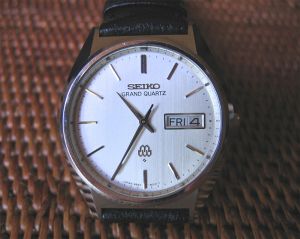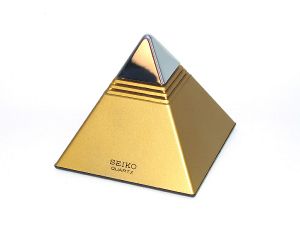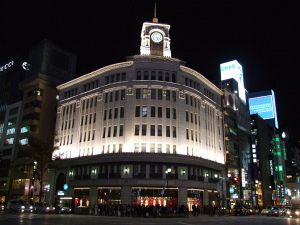Seiko
- This article is about the watch company. For other meanings, see Seiko (disambiguation).
| Seiko Holdings Corporation セイコーホールディングス株式会社 | |
| File:Seiko logo.jpg | |
| Type | Public TYO: 8050 |
|---|---|
| Founded | Chūō, Tokyo, Japan (1881) (Incorporated in 1917) |
| Headquarters | Minato, Tokyo, Japan |
| Key people | Katsumi Yamamura, Chairman; Koichi Murano, President |
| Industry | Retail-Jewelry, Precision Instruments and Machinery |
| Products | Watches, clocks, printers, semiconductors, mechatronics devices, machine tools, optical glass materials, jewelry, eyeglasses, etc. |
| Revenue | |
| Employees | 6,699 (March 31, 2006, consolidated)
|
| Website | Seiko Holdings Corporation
|
Seiko Holdings Corporation (セイコーホールディングス株式会社 Seikō Hōrudingusu Kabushiki-gaisha) (TYO: 8050) (more commonly known simply as Seiko [pronounced say-co]) is a Japanese watch company.
History and ongoing developments
The company started in 1881, when Kintarō Hattori opened a watch and jewellery shop called "K. Hattori" (服部時計店 Hattori Tokeiten) in the Ginza area of Tokyo, Japan. Eleven years later in 1892, he began to produce clocks under the name Seikosha (精工舎 Seikōsha). According to Seiko's official company history, titled "A Journey In Time: The Remarkable Story of Seiko" (2003), Seiko is a Japanese word meaning "exquisite", "minute", or "success". (The meaning "exquisite" is usually written 精巧 while the meaning "success" is usually written 成功.)
The first watches produced under the Seiko brand appeared in 1924. In 1969, Seiko introduced the Seiko Astron, the world's first production quartz watch; when it was introduced, it cost the same as a medium-sized car. Seiko later went on to introduce the first quartz chronograph. In 1985, Orient Watches and Seiko established a joint factory. Recognized as a leader in timekeeping accuracy, Seiko products are often used as the official timekeepers of the major sporting events including the Olympic Games and the FIFA World Cup editions in Argentina 1978, Spain 1982, Mexico 1986 and Italy 1990.
The company was incorporated (K. Hattori & Co., Ltd.) in 1917, renamed Hattori Seiko Co., Ltd. in 1983 and Seiko Corporation in 1990. After reconstructing and creating its operating subsidiaries (such as Seiko Watch Corporation, Seiko Clock Inc.), it became a holding company in 2001 and renamed Seiko Holdings Corporation as of July 1, 2007.
Seiko Holdings is one of the three core companies of the Seiko Group. The Seiko Group consists of Seiko Holdings Corporation (Seiko), Seiko Instruments Inc. (SII) and Seiko Epson Corporation (Epson) which is known for its printers in Europe and North America and its diverse line of electronics and computer equipment within Japan. Although they have some common shareholders including the key members of the Hattori family (posterity of Kintarō Hattori), the three companies in the Seiko Group are not affiliated. They are managed and operated completely independently. Seiko Watch Corporation, an operating subsidiary of Seiko Holdings Corporation, markets Seiko watches while Seiko Instruments and Seiko Epson manufacture their movements.
Seiko is perhaps known best, though, for its wristwatches. Seiko is known for their advanced technology and is one of the few wristwatch manufacturers that produce all of their watches and movements entirely in-house. Even minor items such as the oils used in lubricating the watches and the luminous compounds used on the hands and the dials are produced by the Seiko factories.
Seiko produces both quartz and mechanical watches of varying prices. The cheapest are around US$50; the most expensive (the Credor Spring Drive Sonnerie) costs over $US100,000[1]. Seiko's mechanical watches are the most prized by collectors—from the Seiko "5" series (the 5 is proposed to reflect 5 essential features of the watch namely shock resistant, water resistant, automatic, with day and date display), which is the most common, the Seiko automatic Chronometer series, the "Bell-Matic" with a mechanical alarm to the highly prized luxury "Credor", "King Seiko" and "Grand Seiko" lines. Seiko Kinetic watches account for a large proportion of sales nowadays and combine the self-energizing attributes of an automatic watch with quartz accuracy. There is no battery to change; the watch is entirely powered by its movement in everyday wear.
Frustratingly for collectors, Seiko does not release all of its watch lines in every region. Some are exclusively available in Asia, for instance. Many online retailers will ship watches overseas, though.
Seiko Corporation of America is responsible for distribution of Seiko watches and clocks, as well as Pulsar brand watches, in the United States. The models available in the United States are normally a smaller subset of the full line produced in Japan. Seiko Corporation of America has its headquarters and Coserv repair center in Mahwah, New Jersey. In the United States, Seiko watches are sold primarily by fine jewelers and department stores, as well as 19 company stores located in various cities.
Seiko's 2004 marketing campaign emphasized that a watch, as opposed to other traits (such as what car they drive, for example) tells most about a person.
Various Seiko watches were worn by the cinematic James Bond 007 in four films, starring Roger Moore, from 1977-1985. Also, a Seiko watch was worn by Sean Connery in the 1983 Bond film, Never Say Never Again.
Seiko also produces other electronic devices. Notably, during the 1980's, this company produced a range of digital synthesizers, such as the DS-250, for use in electronic music. Today, the music division, a part of Seiko S-Yard, produces metronomes & tuning devices.
Spring Drive
On 7 October 2005, Seiko announced the world launch of the Seiko Spring Drive, a new calibre which delivers more power, more smoothly and for longer. Three days (72 hours) of power are provided, as opposed to the average of 40 hours in automatic mechanicals. To achieve this feat, Seiko has developed a special alloy called "Spron510". This new movement has eliminated the traditional balance wheel/escapement regulating system in favor of a so-called Tri-synchro Regulator. The power from the spring is used to turn the wheels but also is used to generate electrical power for a tiny, ultra-low consumption (~25 nanoWatts) crystal oscillator which in turn is used to regulate -with quartz accuracy- the speed of the wheels to exactly 8 beats per second. Spring Drive was sold regularly in Japan within the Grand Seiko and Credor lines. Seiko announced that no more than 300 units will be produced on a monthly basis. The Spring Drive also marks the first true luxury Seiko watches available outside Japan. They are expected to retail around $3,200 to $3,500. In the Paris premiere, Seiko auctioned the first Spring Drive, which was sold for about 10,000 euros and the money was given to a Basel-based charity that supports children suffering from cancer and leukemia.
Official timekeeper
Seiko is also the official timer of many major sporting events:
- Tokyo Olympic Summer Games in Japan, 1964
- 1978 World Cup in Argentina,
- 1982 World Cup in Spain,
- 1986 World Cup in Mexico,
- IAAF World Championships in Athletics in Italy, 1987
- 1990 World Cup in Italy,
- IAAF World Championships in Athletics in Tokyo, Japan, 1991
- Barcelona Olympic Summer Games in Spain, 1992
- Lillehammer Olympic Winter Games in Norway, 1994
- Nagano Olympic Winter Games in Japan, 1998
- Salt Lake City Olympic Winter Games in USA, 2002
Seiko is also named as the official timekeeper of the Gran Turismo racing game series, published by Sony.
Currently, Seiko have agreed to sponsor Honda (previously known as BAR (British American Racing) Honda). The Seiko name cannot currently be found on the Honda racing cars because Seiko Japan refuse to be advertised whilst the names of tobacco companies are still appearing on the cars. They can, however, be found on the lollipop used in the pitlane.
Products and services (operating companies)
- Watches — Seiko Watch Corporation
Seiko Watch is a planning and marketing company. Seiko Holdings Corporation delegates a large portion of the manufacturing in its watch business to Epson and SII.- Seiko (Grand Seiko, Dolce & Exceline, Brightz, Lukia, Prospex, iu, Ruse, Spirit, Alpinist, Ignition, Premier, Coutura, Arctura, Sportura, Criteria, Rivoli, Vivace, etc.)
- Credor
- Galante
- Wired
- Wired XYZ
- Alba
- Pulsar
- Lorus
- Clocks — Seiko Clock Inc.
- Decor Seiko
- Seiko Emblem
- Seiko Premium
- Seiko Melodies in Motion Musical Clocks
- Seiko
- Pyxis
- Stopwatches — Seiko S-Yard Co., Ltd.
- Kitchen & cooking timers — Seiko Clock Inc.
- Sports timing equipment — Seiko Time Systems Inc.
- System clocks (outside, building wall, monument, floral clocks) — Seiko Time Systems Inc.
- Time servers — Seiko Precision Inc.
- Printers — Seiko Precision Inc.
- Electronic devices, semiconductors, camera shutters, etc. — Seiko NPC Corporation & Seiko Precision Inc.
- Engineering devices — Seiko Precision Inc.
- Golf clubs — Seiko S-Yard Co., Ltd.
- Musical accessories (tuners, metronomes) — Seiko S-Yard Co., Ltd.
- Jewelry — Seiko Jewelry Co., Ltd.
- Optical lenses & frames — Seiko Optical Products Co., Ltd.
- Upscale specialty retails — Wako Co., Ltd & Cronos Inc.
- Specialty optical glass (glass materials for lenses and prisms) — Ohara Inc. (Seiko owns 32.2% TYO: 5218)
References and footnotes
- ↑ SPRING DRIVE SONNERIE (Japanese)
Road to BASEL WORLD 2006 - CREDOR NODE SPRING DRIVE SONNERIE (Japanese)
External links
- Seiko Holdings Corporation website (Japanese)
- Seiko Holdings Corporation website (English)
- Seiko Watch Corporation website (Japanese)
- Seiko Watch Corporation International website (English)
- Seiko Clocks website (English)
- Seiko Holdings Group Companies (English)
- Seiko Spring Drive website (English)
- Seiko Calibers (English)
- A detailed evaluation of the mechanics of a Seiko 7S26 watch movement (English)
| |||||
Credits
New World Encyclopedia writers and editors rewrote and completed the Wikipedia article in accordance with New World Encyclopedia standards. This article abides by terms of the Creative Commons CC-by-sa 3.0 License (CC-by-sa), which may be used and disseminated with proper attribution. Credit is due under the terms of this license that can reference both the New World Encyclopedia contributors and the selfless volunteer contributors of the Wikimedia Foundation. To cite this article click here for a list of acceptable citing formats.The history of earlier contributions by wikipedians is accessible to researchers here:
The history of this article since it was imported to New World Encyclopedia:
Note: Some restrictions may apply to use of individual images which are separately licensed.


